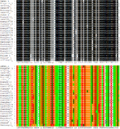Sequence alignment
Sequence alignment is a method used in bioinformatics to arrange the sequences of DNA, RNA, or protein to identify regions of similarity. These similarities may be a result of functional, structural, or evolutionary relationships between the sequences. Aligned sequences of nucleotide or amino acid residues are typically represented as rows within a matrix. Gaps are inserted between the sequences to optimize the alignment and to identify the conservation and changes in different molecular sequences.
Types of Sequence Alignment
There are two main types of sequence alignment: global alignment and local alignment.
Global alignment, implemented in the Needleman-Wunsch algorithm, compares the entire sequence of two entities and is most useful when the sequences are of roughly equal length and are quite similar.
Local alignment, implemented in the Smith-Waterman algorithm, identifies regions of similarity within long sequences that are often widely divergent overall. Local alignment is often used in identifying domains within proteins and parts of a gene in genomes.
Methods of Sequence Alignment
There are several methods used to perform sequence alignment. These include:
- Dot-matrix method - This is a simple but powerful approach used to identify similar regions in sequences.
- Dynamic programming - This method guarantees to find an optimal alignment given a particular scoring system.
- Heuristic methods - These methods are used for large-scale database searches, and include FASTA and BLAST.
Applications of Sequence Alignment
Sequence alignment is used in various applications, including:
- Phylogenetic tree construction - Sequence alignment is used to infer evolutionary relationships between different organisms.
- Protein structure prediction - Sequence alignment can help predict the structure of a protein based on the known structures of other proteins.
- Drug discovery - Sequence alignment can identify potential drug targets by comparing the genomes of disease-causing organisms to those of humans.
See Also
Sequence_alignment
Transform your life with W8MD's budget GLP-1 injections from $125.
W8MD offers a medical weight loss program to lose weight in Philadelphia. Our physician-supervised medical weight loss provides:
- Most insurances accepted or discounted self-pay rates. We will obtain insurance prior authorizations if needed.
- Generic GLP1 weight loss injections from $125 for the starting dose.
- Also offer prescription weight loss medications including Phentermine, Qsymia, Diethylpropion, Contrave etc.
NYC weight loss doctor appointments
Start your NYC weight loss journey today at our NYC medical weight loss and Philadelphia medical weight loss clinics.
- Call 718-946-5500 to lose weight in NYC or for medical weight loss in Philadelphia 215-676-2334.
- Tags:NYC medical weight loss, Philadelphia lose weight Zepbound NYC, Budget GLP1 weight loss injections, Wegovy Philadelphia, Wegovy NYC, Philadelphia medical weight loss, Brookly weight loss and Wegovy NYC
|
WikiMD's Wellness Encyclopedia |
| Let Food Be Thy Medicine Medicine Thy Food - Hippocrates |
Medical Disclaimer: WikiMD is not a substitute for professional medical advice. The information on WikiMD is provided as an information resource only, may be incorrect, outdated or misleading, and is not to be used or relied on for any diagnostic or treatment purposes. Please consult your health care provider before making any healthcare decisions or for guidance about a specific medical condition. WikiMD expressly disclaims responsibility, and shall have no liability, for any damages, loss, injury, or liability whatsoever suffered as a result of your reliance on the information contained in this site. By visiting this site you agree to the foregoing terms and conditions, which may from time to time be changed or supplemented by WikiMD. If you do not agree to the foregoing terms and conditions, you should not enter or use this site. See full disclaimer.
Credits:Most images are courtesy of Wikimedia commons, and templates, categories Wikipedia, licensed under CC BY SA or similar.
Contributors: Prab R. Tumpati, MD




